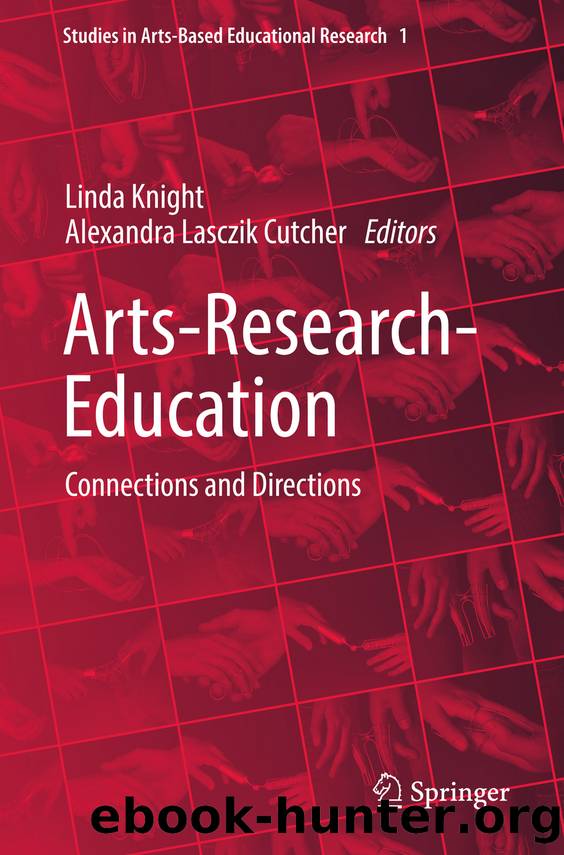Arts-Research-Education by Linda Knight & Alexandra Lasczik Cutcher

Author:Linda Knight & Alexandra Lasczik Cutcher
Language: eng
Format: epub
Publisher: Springer International Publishing, Cham
2 Pedagogies of Contemporary Artists
Kin and Saltbush are two projects that demonstrate the practices and pedagogies contemporary artists utilize to engage audiences (including children) in meaningful and high-quality experiences. Like generalist teachers, artists develop and refine their own practices and approaches to help transfer information as well as prompt the development of practices and concepts of others. Although contemporary artists are doing something similar to a generalist classroom teacher in applying high-quality skills to engage audiences and children, the differences between the contexts of teaching and the contexts of practicing and creating arts, make apparent the differences between the ways practices and pedagogies are learnt, conceptualized, theorized on, and enacted by artists and by teachers.
In Saltbush, the artists negotiate environmental factors such as a transient audience of very young children, a temporary workspace, a digitally responsive sensory floor, along with critical factors such as respectfully telling a story of cultural significance. The artists work collectively with designers and in-house theatre technicians and managers to develop an experience that is more than a visual feast, it must have meaning and affect on those participating. These practices and pedagogies differ from the more fixed or stable workplaces and student cohorts, and the multiple ‘stories’ teachers negotiate in their daily routines.
In Kin Page brings about active and egalitarian collaborations between multi-age groups to enable performers to make collective decisions about the performance works. There is a purposeful deliberation in this process that is not hurried but takes whatever time is required to produce a performance that represents everyone in the group. Pedagogy here emerges through polyvocal and polycorporeal activity that does not hierarchise; this is in contrast to school-based pedagogies that locate the teacher as the central source of expertise on what is to be learnt and how it is to be taught.
These two examples are described in order to show that artists develop and use pedagogic practices. Our comment, and the broader purpose of the chapter aims not to typify the pedagogic practices of artists, or the pedagogic practices of teachers (which we also think of as diverse and fluid) but simply to declare that artists have pedagogic practices. We assert artists think pedagogically when encouraging audiences to appreciate the arts and produce arts works in engaged and participatory ways, and we suggest that although these might differ to the practices and pedagogies seen in daily or routine teaching activity, they are nevertheless, pedagogically authentic, ‘bona-fide’.
Artists and teachers use practices and pedagogies to inspire and educate audiences and children; in acknowledging that these respective pedagogical practices exist how might the pedagogic work of artists be articulated? Specifically, how might artists who work with children and audiences theorise on their pedagogic practices? Finally, how might the work that artists do with audiences be recognised or considered as pedagogic and with equal value as ascribed to the pedagogic work of ‘conventional’ pedagogues such as teachers?
We begin by discussing Helguera’s (2011) studies into the ways artists and audiences work together to participate in art as social practice as a form of transpedagogy.
Download
This site does not store any files on its server. We only index and link to content provided by other sites. Please contact the content providers to delete copyright contents if any and email us, we'll remove relevant links or contents immediately.
The Art of Coaching Workbook by Elena Aguilar(50754)
Trainspotting by Irvine Welsh(21448)
Twilight of the Idols With the Antichrist and Ecce Homo by Friedrich Nietzsche(18452)
Fangirl by Rainbow Rowell(9027)
Periodization Training for Sports by Tudor Bompa(8097)
Change Your Questions, Change Your Life by Marilee Adams(7567)
This Is How You Lose Her by Junot Diaz(6701)
Asking the Right Questions: A Guide to Critical Thinking by M. Neil Browne & Stuart M. Keeley(5577)
Grit by Angela Duckworth(5449)
Red Sparrow by Jason Matthews(5322)
Paper Towns by Green John(5024)
Room 212 by Kate Stewart(4963)
Ken Follett - World without end by Ken Follett(4597)
Housekeeping by Marilynne Robinson(4253)
The Sports Rules Book by Human Kinetics(4215)
Papillon (English) by Henri Charrière(4146)
Double Down (Diary of a Wimpy Kid Book 11) by Jeff Kinney(4145)
The Motorcycle Diaries by Ernesto Che Guevara(3933)
Exercise Technique Manual for Resistance Training by National Strength & Conditioning Association(3906)
